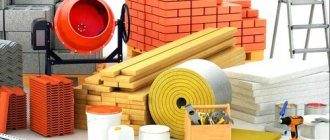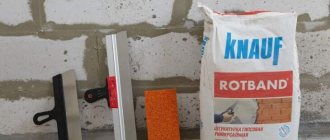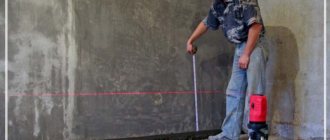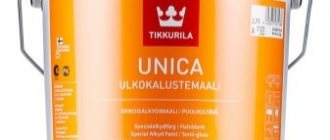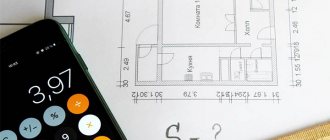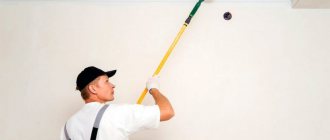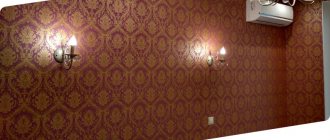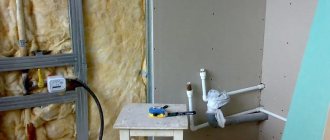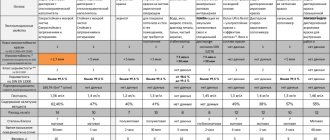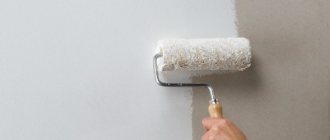Uneven surfaces, cracks, chips, holes are all things that almost every person who has started renovation work indoors faces. In order to correct such defects, putty is used. It is suitable for leveling both concrete and wooden surfaces, both drywall and plastered walls. However, there is one caveat: in order for the work to be done efficiently, you must not make a mistake in choosing the type of putty and its correct quantity. It is especially important to make the correct calculation if the repairs are carried out not by the owner, but by hired workers.
Putty consumption per 1 m2 - table
| Brand | Consumption per kg/m2 |
| Putty UNIS KRON / UNIS KRON Polymer | 1 |
| Putty UNIS LR Plus / UNIS LR | 1 |
| Putty Farvest SMEO-02 Universal | 0.8 |
| STARATELI base putty | 1 |
| STARATELI façade putty | 1 |
| Finishing putty STARATELI | 0.9 |
| Finishing putty STARATELI | 0.9 |
| Putty RUSEAN TT Facade | 1 |
| Putty OSNOVIT VERSILK T-34 gypsum gray | 0.9 |
| Putty OSNOVIT ELISILK T-36 gypsum superthin | 1 |
| Putty OSNOVIT BAZSILK PC 30 MG | 1 |
| Putty OSNOVIT BAZSILK T-30 | 1 |
| Putty OSNOVIT LERSILK T-37 | 1 |
| Putty OSNOVIT ECONSILK PG35 W | 0.85 |
| OSNOVIT GLEDSILK T-38 polymer putty | 1 |
| Putty OSNOVIT BELSILK T-32 cement white | 1.2 |
| Putty OSNOVIT GRAYSILK T-31 cement gray | 1.3 |
| Putty VETONIT FINISH KR / VETONIT FINISH KR white | 1.2 |
| Putty VETONIT FINISH LR PLUS / VETONIT FINISH LR PLUS | 1.2 |
| Putty VETONIT WEBER VH / Weber Vetonit VH white | 1.2 |
| Putty VETONIT WEBER VH / Weber Vetonit VH gray | 1.2 |
| Putty VETONIT FINISH LR PLUS / VETONIT FINISH LR PLUS | 1.2 |
| Finishing gypsum putty LITOKOL LITOGIPS FINISH / LITOKOL LITOGIPS FINISH for interior work | 1 |
| Putty LITOKOL LITOFINISH FINE / LITOKOL LITOFINISH FINE finishing polymer | 1 |
| Putty LITOKOL LITOFINISH FASAD / LITOKOL LITOFINISH FASAD mixture based on white cement | 1.3 |
| Putty KERAFLEKS KR55 Elite | 1.1 |
| Putty Volma Finish gypsum | 1 |
| Volma SHOV gypsum putty for sealing gypsum plasterboard, gypsum board joints | 0.8 |
| Bolars leveling putty | 1.4 |
| Bolars gypsum finishing putty for interior work | 1 |
| Bolars façade finishing putty | 1 |
| Putty PUFAS GLATT UND FULL SPACHTEL / PUFAS GLETT AND FULL SPACHTEL No. 3 finishing thick layer | 1 |
| Putty PUFAS GLATT UND FULL SPACHTEL / PUFAS GLETT AND FULL SPACHTEL No. 3 finishing thick layer | 1 |
| Putty PUFAS FULL+FINISH / PUFAS FULL+FINISH gypsum for interior work | 1 |
| Putty PUFAS FULL+FINISH / PUFAS FULL+FINISH gypsum for interior work | 1 |
| PERFEKTA / PERFEKTA SUPERFINISH gypsum putty | 0.9 |
| PERFEKTA/PERFECTA EKOSTART gypsum putty | 0.9 |
| PERFEKTA / PERFEKTA EKOFINISH gypsum putty | 0.9 |
| PERFEKTA / PERFECTA ECOKRAFT gypsum universal putty | 0.9 |
| Superfinish polymer putty PERFEKTA / PERFECTA ULTRAFINE | 0.9 |
| PERFEKTA/PERFECTA GLIDE PREMIUM cement putty | 1 |
| PERFEKTA/PERFECTA GLIDE STANDARD cement putty | 1 |
| PERFEKTA / PERFECTA START GLIDE cement base putty | 0.9 |
| Putty KNAUF FUGEN / KNAUF FUGEN | 0.8 |
| Putty KNAUF MULTI-FINISH / KNAUF MULTI-FINISH | 1.2 |
| Putty KNAUF Polymer Finish / KNAUF Polymer Finish | 1.2 |
| Putty KNAUF UNIFLOT / KNAUF UNIFLOT | 0.4 |
| Putty KNAUF UNIFLOTT / KNAUF UNIFLOTT | 0.4 |
| Putty HENKEL CERESIT CT127 / HENKEL CERESIT CT127 | 1.2 |
| Putty HENKEL CERESIT CT225 / HENKEL CERESIT CT225 finishing | 1.8 |
| Putty GLIMS Finish Light Room + / GLIMS Light Room + | 1.2 |
| Putty BERGAUF Fugen Gips / BERGAUF Fugen Gips Universal | 1 |
| Putty BERGAUF Finish Plast / BERGAUF Finish Plast | 1.3 |
| Putty BERGAUF Finish Polymer / BERGAUF Finish Polymer | 1 |
| Putty BERGAUF Finish Zement / BERGAUF Finish Cement | 1 |
| Putty BERGAUF Glatte Zement / BERGAUF Glatte Cement | 1 |
| Putty BERGAUF Finish Gips / BERGAUF Finish Gypsum gypsum | 1 |
| Putty BERGAUF Finish Polymer / BERGAUF Finish Polymer based on a polymer base | 1 |
How much Rotband material does it take?
Rotband putty is a material that is actively used when leveling walls and ceilings. In the swarms of the main material there is gypsum, into which components are placed during preparation that increase adhesion. The finished product can be used for leveling surfaces made of polystyrene foam, DSP or plastered walls.
Rotband consumption per 1 m2 with a thickness of 10 mm will be 8 kg. Thus, 1 bag will be enough to process 3.5 m2. It is very important to take into account that the thickness of the applied layer should not be more than 15 mm.
On our website you can find instructions for using Rotband plaster.
Factors influencing material costs
Consumption depends on many factors:
- Conditions of the walls (presence and depth of cracks, curvature, roughness).
- From what you will do with the wall later: glue wallpaper, paint, whitewash.
- From the experience and qualifications of the master.
Correct selection of materials will reduce costs and speed up the process .
First of all, you need to consider the location of the work . For exterior work or wet rooms, cement putties are used. Due to the significant thickness of the layer, more of them will be required than gypsum.
Gypsum mixtures are used in dry interior spaces . There are dry mixtures that need to be diluted with water, and ready-made putty mixtures that do not require any additional actions. The consumption of ready-made ones is much less, however, they are relatively expensive.
Depending on the type of work, putties can be divided into groups:
- Starting - for the initial elimination of cracks, depressions and surface errors. It is this group of putties that accounts for the greatest consumption of materials.
- Universal - its consumption is slightly less than the starting one, but it is also used after the starting one or instead of it on good walls, sometimes it replaces the finishing one.
- Finish - adds gloss to an almost finished wall to create a smooth surface for painting or wallpaper. Very little is required.
These are just preliminary factors to keep in mind. More accurate estimates can be obtained by taking into account the recommended standards.
What to do if mold appears on the walls in the apartment? Read here.
Building materials of famous brands
Material consumption varies depending on the manufacturer of the mixtures. The following brands of putty are popular:
- Sheetrock. The material is intended for interior use. It is used for sealing cracks and seams, and also as a finishing layer. It has increased adhesive ability and elasticity due to the vinyl substances in the composition. Shitrok consumption per 1 m² is 0.5−1 kg of composition for a finishing thickness of 1−2 mm.
- Vetonit. Used for interior work in dry heated rooms. The composition includes cement, limestone, sand, mineral additives and polymer glue. The putty is environmentally friendly and moisture resistant. It is recommended to use the material at temperatures from + 10 degrees Celsius. You need 1.2 kg of mixture for finishing with a thickness of 1 mm. It acquires the stated strength within a week after finishing.
- Knauf. Used for interior work on dry surfaces. Elastic material. Meets environmental standards. Characterized by high adhesion. Consists of lime, gypsum and glue. Knauf for starting finishing is used when the curvature of the plane is up to 3 cm. The mixture is consumed within 1.5 kg per 1 m². Knauf finishing mixture is used for unevenness up to 3 mm. It takes 1.1 kg for finishing. Knauf uniflot is applied with a thickness of 1−5 mm. Approximately 0.25−0.3 kg is consumed.
Depending on layer thickness
You definitely need to pay attention to this aspect, because it affects the quality of the putty layer. Its value should not be less than 0.2 mm. If you apply the solution more than once, then you should start applying the second layer only after the previous one has completely dried.
The thickness also depends on the material from which the putty was made.
For example, if it is an alkyd, this indicator should not be more than 0.4 mm. Also remember about the optimal number of layers - it’s good if it is three or less.
Even if the walls are very uneven, experts do not recommend puttingty in four or five passes.
As an alternative, you can use quick-hardening polyester putties; it is not necessary to work with it in several approaches; it is enough to maintain the optimal thickness of 0.2 mm.
Calculator for calculating mixtures for different types of surfaces
Using a calculator you can calculate the approximate consumption of putty per unit of measurement - 1 m2. A margin of 10% is added to it. It is necessary to take into account separately entered indicators (length and width of the measured surface), base material.
Concrete surfaces absorb a significant amount of moisture due to their porous structure. Therefore, it is necessary to include an additional indicator in the calculation calculator, which will then be increased by at least 0.5. Concrete does not need a thick layer, but the consistency of the composition is important.
If we take a brick base, it is similar to concrete and requires significant costs for absorption. Water must be added several times more than for smoother surfaces. If bases made of other materials are puttied, then the calculation calculator will be approximately the same as conventional calculations. The quantity should also include a reserve of 10% in case of unforeseen expenses.
How much putty is needed per 1 m2
The packaging of the putty indicates the material consumption per 1 square meter with a layer thickness of 1 mm. Take this calculated number, multiply it by the area of the surface being treated, multiply it by the thickness of the layer and add to this an additional 10% in reserve.
Example: let’s say the ceiling area is 12 m2, the putty consumption is 1.2 kg/m2, the required layer thickness is 3 mm. We count: 12×1.2×3+10%=47.52 kg .
General calculation of materials per 1m2 for walls and suspended ceiling
This is the approximate consumption when using gypsum boards 12.5 mm thick on a metal frame (if a partition, then up to 4 m high):
- guide profile PN: 0.7 m;
- PS rack profile: 2.2 m;
- direct hangers: at least 2 pcs.;
- sealing tape (for profiles): 3.2 m;
- reinforcing tape (serpyanka, for example): 1 m;
- self-tapping screws 9 mm: 3-4 pieces;
- 25 mm self-tapping screws: 20 pieces for a suspended ceiling, 12 pieces for a wall;
- dowels and corresponding screws: 6 pcs.
Correctly calculating the amount of materials will save your wallet from unnecessary expenses. However, the consumption of primer and putty can be determined more accurately only at the site of construction of a suspended ceiling, partition or wall.
Types of putties
Putties can differ in their composition, that is, what binder is used in their base:
- Gypsum-based putties are the most common and cheapest. They are used only for interior work and only in rooms with normal humidity levels. They do not shrink and are easy to handle, completely environmentally safe, since gypsum is a natural mineral.
In most cases, gypsum putties are the most justified choice.
- Cement-based putties - used for outdoor work, as well as in those rooms where the humidity level is higher than usual - baths, bathrooms, swimming pools, kitchens and others. They are more expensive than gypsum, can shrink slightly, and have a longer drying time.
- Polymer putties are the most modern, which are based on some kind of polymer: acrylic, vinyl or latex. In addition to the polymer, they contain various mineral fillers in the form of marble flour, fine-grained quartz sand, limestone, dolomite and others, as well as various plasticizers and modifiers, the name and percentage of which is carefully hidden by each manufacturer.
Polymer putties show their best qualities when working with plasterboard surfaces
The above-mentioned plasticizers and modifiers, various polymer components are included in the composition of both gypsum and cement putties, which are designed to improve their properties.
Putties come in two stages of readiness:
- Dry mixtures , which are most often packaged in paper bags and prepared at the point of use by adding a solvent. In the vast majority of cases, clean water is used for this. Obviously, such putties are easy to transport and store, they are cheaper, and they can be prepared in the required quantities right on the job site. However, if the preparation technology is not followed and the mixture preparation time is exceeded, the properties of such putties are sharply reduced.
- Ready-to-use putties , which are most often packaged in plastic jars or buckets. The advantages of such compositions are obvious - they do not need to be prepared, when the lid is closed they retain their properties throughout the entire guaranteed shelf life, they are easy to apply, and when using them there is a minimum of waste. Most often, ready-to-use putties are polymer. Their main disadvantages are the higher price and, unfortunately, the presence of a large number of counterfeit products on the market. Therefore, you should purchase them only from trusted sellers.
According to their purpose, putties are divided into:
- Starting or leveling putties . They can also be called first-layer putties. Their main task is to level the uneven base of the wall after plastering work, and the applied layer can be of variable thickness from 1-2 mm to 1.5-2 centimeters. Naturally, it is unlikely that it will be possible to apply a layer of 1.5-2 cm at a time, so puttying with the starting composition is carried out 2 and sometimes even 3 times. Such putties have a larger aggregate fraction. The thickness of the applied layer at a time is always indicated on the packaging of the putty.
- Finishing putties are intended for applying the first layer of putty and their main task is to obtain a perfectly flat and smooth wall surface, ready for final finishing: wallpapering, painting, cladding or decorative plaster. Before applying them, the starting putty must be thoroughly sanded and primed. The filler fraction size of such putties is significantly smaller, the layer thickness is from fractions of a millimeter to 1-3 mm. Trying to apply a thicker layer of finishing compound will almost always result in peeling.
- Universal putties combine the qualities of starting and finishing putties. They are used on fairly flat bases, for example, a wall in a concrete panel house, which will later be covered with wallpaper with a three-dimensional texture. This does not require a large layer to level and a surface that is too smooth for painting or thin wallpaper.
Prices for Ceresit putty
putty Ceresit
One of the best universal putties, but also expensive
What is the advantage of ready-made formulations
We are talking about a material that does not need to be additionally mixed with water; it is sold completely ready for use. In terms of its functional characteristics, it is superior to dry mixtures. Just look at the content of plasticizers, vinyl substances and other components that improve adhesion. This also has a positive effect on the integrity of the coating, which does not crack over time. For 1 square meter you will need a maximum of 0.5 kg of the finished mixture.
Ready-made putty mixtures are easy to use and provide good results after application
Today, Shitrok is considered the most popular. This product is characterized by ease of use, quick drying, and the absence of asbestos. In addition to being ideal for sealing seams between sheets of drywall, it can withstand up to 5 freezing cycles. As for the disadvantages, there is only one - the high price.
To avoid overspending, try to strictly follow the technology. Experts recommend diluting the putty in a plastic container, such as a paint bucket. The main rule is to breed often, but little by little. There is no need to waste time completely eliminating lumps, because they will disappear on their own during the process.
Consumption of starting putty
Such mixtures are applied to plastered surfaces and precede the finishing stage. Often the compositions differ in large fractions, because made from gypsum powder and lime. The consumption of the starting putty mixture is high, so manufacturers produce the material in 25-42 kg bags. To dilute 1 kg you will need up to 400 ml of water, the consistency of the material is pasty.
When applying the mixture to a wall panel with a layer of 1 millimeter, the consumption of starting putty will be up to 1-1.4 kg per 1 m2. Typically, 1 package weighing 30 kg is enough to carry out initial puttying of an area of 20-20 m² with small defects. However, if the panels are damaged, the thickness of the putty will be at least 0.5 cm, so a bag will be enough for 4-7 m² of area.
It is recommended to determine the required thickness of 1 layer before puttying work. The standard value is no higher than 0.5-1 cm. If the layer thickness is exceeded, the finishing mixture may shed.
You can calculate how much material is needed taking into account the technical characteristics of different products:
- Knauf HP Start putty can be applied in a layer of 10-30 mm; with a coating of 10 mm, about 7.5 kg will be required for an area of 1 m²;
- Ceresit CT 29 starting mixture is applied with a thickness of 2-20 mm; with a layer of 1 mm, up to 20 kg of product will be required;
- Polimin SHG-11 mixture is used to make a 3-10 mm coating, the consumption with a 1 mm layer will be more than 1 kg;
- SATYN PW-01 - permissible coating up to 8 mm; with a layer of 1 mm, product consumption will be 1.3 kg.
Learning to save
Anyone who is going to renovate an apartment or house is interested in the question of how much one or another building material should be bought. And is it possible to calculate the consumption of finishing putty per 1 m2 of plasterboard wall?
You should know that the rate of mixture consumption per square meter is based on the following data:
- the area that will need to be processed;
- the type of existing coating, the type of unevenness on it, the presence of various defects;
- the type of mixture you are going to use, the size of its fractions (the starting one has a larger structure, so the layer from it will be thicker and, quite understandably, the quantity will be larger).
Before you start counting, you should read the recommendations on the putty package. Consumption indicators are indicated there.
Consumption
Thus, we calculate how much putty we need to process 1 m2 of surface, which has a thickness of 1 mm.
The formula here is:
1 m ∙ 1 m ∙ 0.001 m = 0.001 m3
In accordance with it, we calculate how much putty (X kg) we will need to level 1 square meter. m of surface of the layer thickness we need (U mm):
0.001m3 ∙ Y ∙ material density (kg/dm2) = X kg/m2
To this result, you need to add another 15 percent for unplanned expenses. By the way, the thickness of the layer is determined by the largest depression on the surface.
You can find out about density indicators on the packaging or ask the seller. Naturally, it varies and is in the range of 0.8-1.6 kg/dm2. It is quite clear that the higher the indicator, the more solution will be used per 1 m2.
Putty consumption rates
Information on optimal standards is provided by the manufacturer. Typically, the consumption is indicated based on a layer thickness of 1 cm for starting putties and 1 mm for finishing putties.
The starting putty is applied to a pre-plastered wall that has no significant defects. The thickness of each layer should not exceed 10 mm, and the total thickness should not exceed 30 mm, otherwise the coating may crack and peel off.
For a smooth wall, a layer 1 mm thick is sufficient - then 0.8-0.9 kg/m2 will be required, but if the cracks and irregularities are significant (up to 10 mm), the consumption can increase tenfold.
As an example, consider the Knauf NR Start starting putty. Recommended consumption for a layer thickness of 10 mm is up to 10 kg/m2. A standard 30 kg bag is therefore enough for 3-3.5 m2 of surface. The surface turns out to be quite grainy (grain size up to 1.3 mm) and dries up to 7 days. After this, you can begin final processing.
Finishing putty is a homogenized mixture with a very fine structure (up to 0.3 mm), intended for final leveling of walls.
It is applied in a thin layer so that it does not float when wet and does not crack as it dries. The optimal layer thickness is 0.5-1 mm.
The consumption for putties from different companies is almost the same. For example, for Vetonit Finish Plus putty with a layer thickness of 1 mm, the recommended consumption is approximately 1.2 kg/m2, a 25 kg bag should be enough for 20-25 m2.
Finished putty - the so-called putty surface. It is used for leveling ceilings , relatively smooth walls or minor damage to carpentry. The additives included in its composition (plasticizers and vinyl substances) significantly improve the quality of the surface.
These mixtures have a number of advantages over dry formulations:
- ready to work immediately;
- dry faster;
- do not crack after drying.
One of the most economical is the Sheetrock mixture: with a layer thickness of 1 mm, only 0.5 kg/m2 is needed. The consumption of other putties (Knauf, Pufas) can range from 1.5 to 1.7 kg/m2.
Calculation procedure
Having determined the consumption rate per 1 m2 of surface, you can proceed directly to calculating the amount of putty. First, determine the area of the treated surface. Let it be 55 m2. Taking into account the consumption rates, we find that the starting mixture will need 55 * 1.5 = 82.5 kg, the universal one - 55 * 1 = 55 kg, and the finishing mixture - 55 * 0.4 = 22 kg.
The result obtained must be increased by 10-15%. Therefore, the final value will be 90.75 kg, 60.5 kg and 24.2 kg, respectively. Knowing how much material is in one bag, you can calculate their quantity. For example, if you take 5 kg bags, you will need 19 bags of starting putty, 12 bags of universal putty, and 5 bags of finishing putty. These data will help you choose the most economical option in terms of weight and cost.
The finished putty is sold in sealed containers and does not require dilution. It can be used immediately for work. It costs more than dry mixture, but allows you to reduce preparation time. The consumption of ready-made putties is 0.5-1 kg per 1 m2, which is a very good indicator compared to dry mixes. The advantage of this type is its high quality. Due to various additives and plasticizers, the finished putty is easy to work with, it does not shrink, and dries quickly.
Which option to choose depends on the volume of work and financial capabilities. If you need to treat 20 m2 in a residential area, then it is better not to save. And when processing 1000 square meters of production space, you can get by with a dry mixture.
Consumption of basic putty
It is intended for primary processing - sealing cracks or leveling. The required amount of this material is determined based on:
- Initial goals of starting treatment;
- Condition of the walls. The more unevenness, the more mixture will be required.
Approximate consumption of putty per 1 m2 of plaster when using starting putty in digital equivalent.
For example, with a 10 mm layer, on average, about 10 kg of material will be needed. Simply put, for each individual square meter, an average of about a kilogram of putty is used.
Some builders, in order to save money, add sand to the solution.
Advice from material consumption consultants
Professional advice that allows you to get high-quality results when leveling walls with putty mixture at its optimal consumption rate:
- the consumption of the building composition directly depends on the mixture used, the surface being treated (depth of defects, curvature) and the thickness of the applied layer (stage of work). This means that pre-leveling the wall with plaster will help reduce putty consumption.
- you need to take into account the type of room when choosing the type of building mixture. For wet rooms (kitchen, bathroom, toilet), cement-based putty is suitable.
- When independently preparing a composition from a dry mixture, you must strictly follow all the instructions indicated on the packaging. If the putty is prepared incorrectly, this will significantly increase its consumption.
- The thicker the composition, the greater the consumption. But this does not mean that to save money you need to dilute the liquid mixture. It all depends on the goals being pursued. For large irregularities, for example, a thick putty is needed
- no need to apply 10 cm layers of plaster, putty, etc. Under the weight of its own weight, there is a high probability that the building material will crack and collapse
Thus, when puttingtying work you need to take into account many nuances:
- work stage
- condition of the walls
- type of building material
- master's qualification, etc.
But on average, without taking into account the unique circumstances of each specific situation, the putty consumption per square meter is 1 kg.
Preparatory work
In order to get a high-quality result at the end of the putty work, you need to carefully prepare for this process.
1. Preparation of the base (ceiling or wall):
- must be durable
- dry
- clean
- without peeling
It is necessary to remove dirt, plaque, plaster residues, wallpaper, looseness, oily inclusions, etc.
The wall or ceiling should not be wet or frozen. Before puttying, be sure to dry the base.
2. Preparation of the workplace. Since the process of leveling walls is a dusty and dirty job, it is necessary:
- cover the floors with newspapers or special film
- It is better to remove decorative items and furniture; if this is not possible, then also cover with film
3. Preparation of tools. You will need a drill with a special attachment (or something you will use to mix the dry mixture manually), spatulas, a container for the composition and a level (if you have to work on leveling the walls/ceiling). All equipment must be clean and dry.
The tool must be washed thoroughly immediately after use, otherwise it may only end up in the trash.
4. Preparation of the building mixture (read more about this below).
Costs of universal mixture
Universal dry putty mixtures are popular due to their ease of storage. The remaining material is stored for a long time in dry rooms. Start-finish compositions are used for finishing well-prepared surfaces. After application, if the result does not meet the requirements, you can use the finishing mixture. The universal composition is packaged in 20 kg bags. This is enough to process a surface of 15-20 m2. There are bags of 25 kg.
The universal mixture Stabilll PSZ - 11 is consumed from 1.2 kg per meter of 1 mm plane. Packaged in 20 kg packs. It is allowed to use 4 plane treatments to create a layer of 30 mm.
The Sniezka Acryl-Putz composition will need 1.5 kg per meter of 1 mm plane.
The Knauf Multi-Finish gypsum putty composition is popular. It is consumed at the rate of 1.2 kg per meter of plane with a layer of 1 mm. According to the data on the packaging, 25 kg of the mixture is enough to finish 20 m² of wall.
Depending on the type of putty and the quality of the surface being treated, the mixture consumption also changes. You also need to take into account the manufacturer's brand. It is necessary to purchase materials in reserve, since it is impossible to predict all the nuances of repair work. It should be taken into account that dry mixtures can be stored for a long time in heated rooms. Ready-made compounds will have to be disposed of when no longer needed . This also applies to ready-made polymer mixtures.
Review of the most famous and used putties
If you try to count all the types of putties that are available in a good construction hypermarket, it will take at least several hours. And if you try to study all the technical characteristics, it will take much more time. Therefore, it was decided to give a short overview in the form of a table, which presents putty mixtures from the world's leading manufacturers, the quality of which has been tested by time.
| Image | Name, packaging | Purpose and description | Thickness of applied layer | approximate price |
| KNAUF Rotband-Finish gypsum putty , packed in 20 kg and 25 kg bags. | Apply over gypsum, cement plasters or plasterboard sheets to prepare for a quality finish. | 0.2-5 mm | 400 rubles per 25 kg bag. | |
| Gypsum putty KNAUF-HP Finish , packed in 25 kg bags. | For filling surfaces with a solid base indoors with normal humidity levels. | 1-3 mm | 270 rubles per bag of 25 kg. | |
| KNAUF Multi-finish gypsum finishing putty , packed in 25 kg bags. | For filling surfaces with a solid base, as well as thin-layer plastering (3-5 mm) indoors with normal humidity levels. | 0.15-5 mm | 400 rubles per 25 kg bag. | |
| Ready-made finishing putty KNAUF Rotband – Paste , packaged in buckets of 5 kg and 20 kg. | For finishing puttying of plasterboard sheets, as well as surfaces plastered with gypsum or cement plasters. After application, the surfaces are ready for a high-quality finish. | 0.1-3 mm | 650 rubles per 20 kg bucket. | |
| Ready-made putty mixture KNAUF Multi-finish paste , packaged in 5 kg and 20 kg buckets. | For sealing joints of plasterboard boards and other sheet materials, puttying any surfaces: plastered, concrete. After treatment, the surfaces are ready for painting, gluing and applying decorative plasters. | 0.1-3 mm | 700 rubles per 20 kg bucket. | |
| Cement facade putty KNAUF Multi-finish , packed in 25 kg bags. | For high-quality leveling of concrete surfaces and cement plasters both outside and inside – in rooms with high humidity, as well as for filling holes and sealing cracks. | 1-3 mm | 350 rubles per 25 kg bag. | |
| KNAUF-Rotband Paste Profi , ready-made paste-like finishing putty on a vinyl base. Bucket packaging: 5 kg and 18 kg. | For finishing putty (for stripping) of any surfaces (except wooden) for painting, wallpapering, or applying any other high-quality finishing materials. | Up to 2 mm | 800 rubles per 18 kg bucket. | |
| Ceresit CT 127 . White finishing polymer putty for interior work, packed in 25 kg bags. | For filling minor defects and finishing leveling of any hard surfaces inside buildings. After use it can be painted or wallpapered. | Up to 3 mm | 550 rubles per 25 kg bag. | |
| Ceresit CT 95 . Ready-made white finishing polymer putty, packaged in 5 kg and 25 kg buckets. | For use on any hard surfaces (except wood) indoors. After sanding, the surface is as smooth as possible, ready for any finishing. | Up to 3 mm, in one pass the layer thickness should not exceed 1.5 mm. | 1300 rubles per 25 kg bucket. | |
| Weber.vetonit LR+ . Finishing white putty with a polymer binder, packed in 5 kg and 25 kg bags. | For finishing leveling the surfaces of walls and ceilings indoors with normal humidity before painting or wallpapering. | 1-5 mm | 660 rubles per bag of 25 kg. | |
| Weber.vetonit KR . Finishing white putty with an organic binder, packed in 5 kg and 20 kg bags. | For application to plastered surfaces, plasterboards (except seams). | 1-4 mm | RUB 399 per 20 kg bag. | |
| Weber.vetonit VH . Finishing cement putty, moisture-resistant, white, packed in 5 kg and 20 kg bags. | For external and internal works. Can be applied to cement plasters, concrete, foam concrete, brick, plasterboard sheets. | 1-3 mm | 490 rubles per 20 kg bag. | |
| Weber.vetonit LR Fine . White super finishing polymer putty, packed in 25 kg bags. | For super-finish leveling of walls and ceilings indoors. | 0.5-3 mm | 680 rubles per 25 kg bag. | |
| Weber.vetonitJS . Universal white polymer putty, packed in 5 kg and 20 kg bags. | For leveling old painted surfaces, finishing leveling before painting or wallpapering. | 1-2 mm | 630 rubles per 20 kg bag. | |
| Sheetrock All purpose joint compound , universal polymer-lime putty with a vinyl-based binder, packaged in 5 kg and 28 kg buckets. | For interior work, used in rooms with normal humidity. Can be applied to almost any hard surface except wood. Excellent for sealing drywall joints. Sands beautifully and the finished surface is ready for any high quality finish. | Up to 2 mm | 1100 rubles per 28 kg bucket. |
The data in the table is quite enough to evaluate what putties exist, since everything from other manufacturers is very similar. The given compositions of these particular brands in no way detract from the merits of others, but simply give a general idea.
What is Shitrok APJC finishing putty?
Almost all types of finishing putties are made on a polymer base with the addition of fine fillers, gypsum, resins and stabilizers, which makes most types of thin-layer finishing materials somewhat similar to each other in characteristics and capabilities. But even in such conditions, the use of Shitrok putty makes it possible to bypass its closest competitors, for example, Vetonit and Multifinish, in terms of the quality of the resulting surface.
The main difference from competitors is that Shitrok, like putty, is a highly specialized material that is good only under specific conditions of use:
- The thickness of the laid layer does not exceed 0.1-0.5 mm, although the manufacturer allows a maximum thickness of the working layer of up to 2 mm;
- After applying the putty, the surface is not sanded or sanded;
- Finishing putty is not used to level the walls; the surface is covered with the thinnest possible layer, filling the risks, microcavities and pinhole defects remaining from the preliminary finishing.
The finishing compound Shitrok is used in 99 cases out of 100 for final finishing before painting walls. After drying, the finishing putty gives the effect of frosted glass - an even and uniform layer, translucent in thickness. Once painted, it is almost impossible to tell how many layers have been laid on the drywall or concrete surface. You can apply two or three layers with polishing, but the total thickness of the finishing putty should not exceed 2 mm.
The secret of the composition of the branded finishing material Shitrok
Most craftsmen who professionally prepare walls using putties recognize the high plasticity of the Shitrok finishing mass, excellent adhesion and relatively low shrinkage of the material. Specialists from the manufacturing company provide the following approximate composition of Shitrok APJC:
- Finely ground limestone or dolomite of fraction 20-40 microns, most often these are magnesium-calcium carbonates of natural origin;
- Ethylene-vinyl or acetate-vinyl copolymers;
- Atapulgite and pyrophyllite, which provide a dry sliding effect, when the finishing putty, even with too much pressure from the spatula on the surface, easily slides over a dry base.
But this does not explain all the nuances of high ductility and strength. In fact, the composition of the putty should be much more complex and voluminous than what American technologists say. At a minimum, the Shitrok finishing mass must include mixture separation stabilizers, preservatives and thickeners.
As an additive that can make the finishing putty more airy and viscous, like whipped butter cream, cellulose microfiber is used, which is quite expensive and difficult to produce. The fiber provides excellent ductility and strength of the Shitrok layer even on a glass surface. To prevent microcellulose from causing the development of mold or mildew, liquid preservatives based on polyhydric alcohols are always included in the formulation for the production of Shitrok putty.
Tips for preparing a putty mixture solution
If you purchased ready-made putty, you can immediately apply it to the wall. But dry - requires proper preparation.
A solution from a dry mixture can be prepared manually or using electrical equipment.
Rules for preparing the composition if a power tool is used:
- The container for the solution must be dry and clean
- First, water is poured in and only then the dry mixture is added to it
- The required ratio of water and dry mass should be looked at on the packaging
- the finished composition should be left to brew for 15 minutes and then mixed again
- If an electric tool is used for mixing, then it is necessary to use a low rotation speed. Otherwise, the finished mass will turn out to be oversaturated with oxygen, porous and fragile
Rules for preparing the mixture manually:
- The container for the solution must be dry and clean
- first the solution is poured, and then water is added
- The required ratio of water and dry mass should be looked at on the packaging
- the finished composition must be thoroughly mixed and left for 3 minutes, after which the material can be used
Properly prepared putty should be plastic, homogeneous (without lumps) and easy to apply to the surface. The material should not stick to the spatula, nor should it drain from it.
You also need to remember about proportions. If there is a large amount of work ahead, you should not dilute the entire mixture at once. The putty hardens quickly, and if the entire composition is diluted at once, the risk of unjustified expenses is very high.
Sheetrock, Knauf “Rotband paste” or Vetonit LR - which is better
The materials listed are the most popular among finishers. But there are features that must be taken into account when choosing. Thus, Shitrok creates the smoothest surface even without sanding. After sanding, it must be primed, but without sanding this step can be skipped. Shitrok is ideal for painting, the most durable.
Primer must be applied on top of Vetonit; this material is best suited for subsequent wallpapering. The disadvantage of Vetonit in comparison with Shitrok is less plasticity, but the color is perfectly white. Another disadvantage of Vetonit is the need for dilution, while Shitrok is a ready-made mass.
About the need for the procedure
Before we talk about the consumption of drywall putty for painting, let's figure out why putty drywall at all? This question often arises because this material itself has a smooth, even surface, and, it would seem, does not require additional processing. But in reality it's not like that.
Not only do plasterboard walls need to be puttied, you can’t even do without a specialized starting mixture.
The whole reason is in the process of covering walls and ceilings with this material. To ensure proper shrinkage of the plasterboard sheets, it is necessary to leave small gaps between them. They are reinforced with a special mesh and covered with a starting solution. And before this, the joints, corners and points of attachment with screws are primed.
Example
Let's say you need to treat four walls 2.7 m high in a room whose dimensions are 4.5 by 5.3 meters. For this you are going to use a universal Fugenfüller compound, gypsum type. The average layer thickness will be 4.5 mm.
We multiply the figure 0.9 by 4.5 (coating thickness) - we get 4.05 kg. We calculate the area of the room - we multiply both size indicators separately by the height, plus both numbers, the result is 52, 92. Now we multiply this value by 4.05 - 214.326 kg. This is the required size.
All that remains is to calculate how many bags are needed - for example, if one bag weighs 25 kg, then dividing the sum of 214.326 by this number will result in 9 bags.
First you need to figure out which putty consumption for the wall needs to be calculated. If the external walls are to be finished with putty, then the material consumption will be greater than for internal work.
For example, Vetonit putty is used for finishing rooms with a high level of importance, and is applied with a middle layer. The same layer is applied to adhesive putty, because it involves applying a special adhesive paint, which is thick in structure and adds extra volume to the surface.
Gypsum and finishing types of putty are designed to be applied to surfaces in a thin layer; their consumption will be significantly less than that of other types of material.
The approximate consumption of putty per 1m2, according to the material, is given below.
- Vetonit putty, its consumption per 1 m2 is 1 kg 200 g;
- Adhesive putty is used on walls with a consumption of up to 500g per 1m2;
- Finishing putty consumption for walls per 1m2 is 450g;
- Gypsum putty is used on walls with a consumption of 900 g per 1 m2.
Before you begin finishing the walls outside and inside, you need to take into account the material on which the putty is applied. The starting external putty is applied to cinder block, brick, wood (with mesh) and covers significant flaws and unevenness in the walls.
How much putty needs to be applied to the walls and in how many layers depends directly on the walls of the building. On the outside of a brick and cinder block building, the first, rough layer is applied using starting putty. Starter putty can be applied up to 2-3 layers. Then the starting layer of putty is covered with finishing putty once or twice, depending on the type of putty.
It turns out that the first layer of such putty serves as a start, and the second layer of putty completes the finishing of the wall and serves as the finish. Acrylic and silicone putty is applied in one layer, it is quite convenient to use, in the sense that the required volume can be laid out in one layer.
In order to purchase the required amount of putty for repairs, you need to know the exact area of the room along the perimeter and height of the walls. The expense can be made manually, knowing the following data: the sum of the length of all walls in the room, the height of the walls, the length and height of the wall above and below the door. The width and length of the walls, the thickness of the material applied taking into account unevenness are taken into account.
Calculation using the formula:
- Multiply the rate of material consumption per 1 m2 by the thickness of the irregularities, which we took into account in the calculations;
- Add up the length of all the walls in the room;
- Multiply the length of the wall above the doorway by the height of this section, and add the sum of the height of the walls to the indicator;
- To action 1 add the amount of action 2. Multiply the resulting amount by the number of action 3.
Ways to solve the problem
Most often, finishers use the time-tested method of laying a trial plot. Select one small part of the wall, which is conventionally taken as the standard. A full range of work is carried out on it. Primer, plaster and subsequent putty. The exact consumption of materials per 1 m2 is calculated and compared with the data provided by a standard calculator.
By drawing up a simple mathematical proportion, an error coefficient is derived, which is subsequently used to work on leveling all other walls. This method makes it possible not to exceed an error of 2-3% in further calculations. Thus, the consumption of plaster becomes more predictable when purchasing materials.
If the wall plastering is done efficiently, the calculation of putty consumption should practically not differ from the data provided by the calculator. Increased consumption of putty occurs mainly when the walls are not leveled enough and it is necessary to level this out with putty. In such cases, the consumption of putty per 1 m2 can reach the most unexpected levels.
The optimal option is when plastering and putty are carried out by one person or one team. Then responsibility for the final result cannot be shifted to the mistakes of the previous performer. This is another point, already organizational, but the consumption of plaster also depends on it.
High-quality leveling of walls and preparing them for further painting or wallpapering is the most important condition for performing all subsequent stages of construction or repair.
It is very difficult to stick wallpaper well to uneven walls: the edges of the sheets may not match due to the geometric curvature of the surface. The lighting in the room will be uneven, as the bumps and depressions will create shadows. Highlights and partial shadows form on the ceilings. Installation of furniture and wall equipment becomes more difficult.
In addition, the consumption of plaster is significantly affected by the selection and quality of materials used in the work, and their storage conditions.
For example, cement mixtures give, although small, but noticeable shrinkage, a greater number of roughnesses and cellular formations on the surface of the wall. This, in turn, leads to the fact that the consumption of putty per 1 m2 of plaster will be overestimated.
Such mixtures are used mainly for plastering the external walls of buildings, as well as in rooms with high humidity. There is absolutely no need to cover the walls of interior and living spaces with cement plaster.
Plasters based on gypsum, chalk or lime are smoother and do not shrink. They are produced in the form of dry mixtures and are convenient for transportation. They are well polished and processed to the required condition. In addition, many of the manufacturing companies add synthetic plasticizers to such mixtures, which makes these mixtures more elastic and resistant to mechanical damage.
Using tables or a calculator to calculate the consumption of plaster and putty when using such materials is more justified and appropriate.
And finally, the consumption of plaster directly depends on the professionalism of the craftsmen performing the work.
A scrupulous customer should always remember that a good master is more expensive than a beginner. But in the end, betting on skill always pays off handsomely. Confirmation of this will be the consumption of plaster.
How to calculate?
For plaster
Assess the quality of the wall and the required layer thickness. Decide whether you will putty the entire wall or just defects and damaged parts, evaluate the area to be treated.
If the wall is perfectly smooth, it is enough to apply 1 mm of starting putty (1 kg/m2) and 0.5 mm of finishing putty (0.6 kg/m2).
Increasing the layer thickness increases the consumption proportionally: for a 10 mm layer of starting putty, 10 kg/m2 will be required.
Keep in mind that re-plastering is often required! The second layer is usually thinner than the first (up to 3 mm), but it also needs to be included in the calculation. The consumption of finishing putty varies slightly, up to 1-1.2 kg per m2.
Example: a relatively flat wall 2.6 m x 3 m = 7.8 m2 with small cracks and minor defects. The estimated layer of starting putty is 3 mm (3 kg per m2). Required amount of dry mixture: 7.8*3=23.4 kg. Approximately 8 kg of finishing putty will be required.
But you need to keep in mind that different sections of the wall may require different amounts of putty!
For drywall
Despite the perfectly smooth surface of an individual sheet, there will always be joints between the sheets that need to be sealed. You also need to hide the heads of the screws that secure the sheets. Therefore, it will not be possible to limit yourself to just finishing putty.
There is usually up to a kilogram of mixture per square meter. The choice of material depends on the room conditions: cement putty (~1.1 kg per m2) is recommended for wet rooms, gypsum (1 kg/m2) or polymer mixtures (0.5 kg/m2) are recommended for dry rooms.
On a smooth concrete wall
Smooth concrete walls must be treated with a primer before puttying and only then apply a layer of putty (no more than 6 mm for the first layer and no more than 3 mm for the second). You can also putty on wooden surfaces, but the layer of putty should be minimal, no more than 2-3 mm.
Please note: no matter how carefully you work, some of the solution will remain on buckets, on tools, on the floor. Inept handling of mixtures can also significantly increase consumption; sometimes the composition hardens before you have time to use it, or you have to redo certain areas
These inevitable losses can account for up to 10% of the total, so it is better to have some supply of materials
Inept handling of mixtures can also significantly increase consumption; sometimes the composition hardens before you have time to use it, or you have to redo certain areas. These inevitable losses can account for up to 10% of the total, so it is better to have some supply of materials.
This video explains how to correctly calculate the putty consumption.
Final processing
The consumption of finishing putty from different manufacturers is approximately the same, but in an effort to reduce it, craftsmen use vinyl-based compounds more often than others. Finishing wall putty is a composition with which the process of applying a minimum layer of mixture to a prepared, flat surface is carried out. Such putties are needed to make walls smooth and are usually used when preparing walls for painting.
You can calculate the amount of finishing putty if you know what composition will be used to create the final layer on the surface. Most mixtures are applied in a layer of no more than 1 mm, but there are also compositions that are applied to the surface in a layer not reaching a thickness of 1 mm. They are produced and sold in the form of dry mixtures or ready-made formulations, packaged in buckets of various sizes.
Using a special tool, a “shitrok,” allows you to create a smooth, even layer, the thickness of which does not exceed 0.2-0.8 mm.
Finishing putty is an elastic homogenized mixture, which includes binding elements no larger than 0.3 mm in size. When applied correctly, the consumption of finishing putty per 1 sq.m. walls will be from 0.8 to 1.2 kg of the finished mixture. The consumption of a composition prepared from dry matter may be slightly higher, since water is added to it independently, and the consistency of the solution depends on the amount of liquid.
You can more accurately calculate the amount of composition consumed by multiplying the standards established by the manufacturer by the total area of the surface being treated, and adding 15% of the standard to the result obtained.
A small amount of water will not make the mixture sufficiently elastic; the solution on the surface of the wall with the base putty applied to it will dry too quickly, since the water from it is absorbed into the previous layer of finishing material. Video instructions will help you make the correct calculations, based on the characteristics of the base of the walls and the finishing mixtures themselves.
By correctly calculating the consumption of finishing putty, you can control the thickness of the applied layer. Using more material indicates exceeding the permissible coating thickness.
Which putty should I choose? review of putties from famous manufacturers.
Based on their composition, putties are divided into gypsum, cement and polymer (acrylic). Gypsum putties are relatively inexpensive, easy to level and practically do not shrink. Their only drawback is poor resistance to moisture, which limits their scope of use. Cement-based putties have excellent moisture resistance, but have a high degree of shrinkage. Polymer putties are waterproof, do not shrink and at the same time provide a very high quality of the finished surface. Their only drawback is their too high price.
